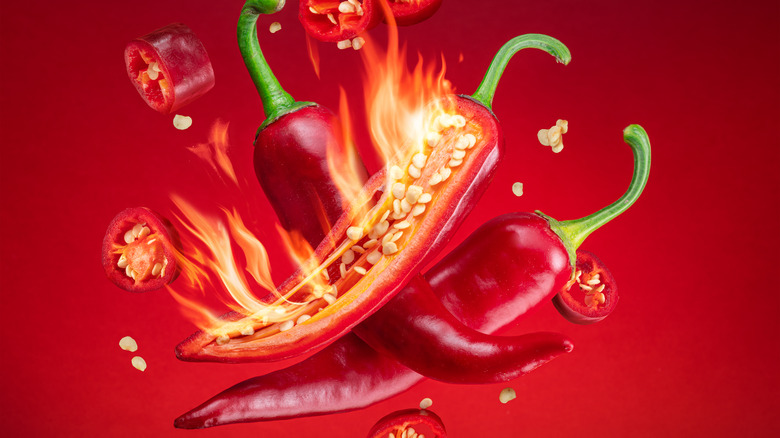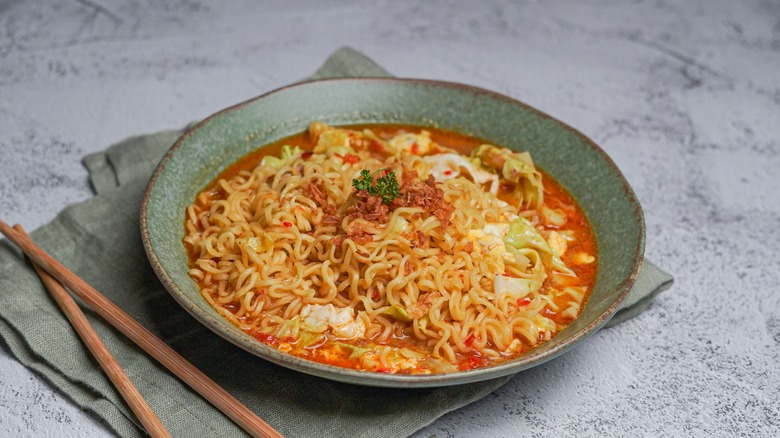One Jakarta Restaurant's 'Death Noodles' Boast A Scoville Rating Of 20 Million
Spice is an interesting part of food culture. Some people can't take the heat of even the mildest jalapeño, while others revel in the flames of finding the fieriest dishes available. Interestingly, "spice" isn't a flavor in itself — it's actually pain — that is caused by capsaicin molecules in food. Capsaicin mimics something super hot, which then leads to pain because of the perceived high temperature.
We might not entirely understand why some people like spicy food, and others don't, but the pursuit of hot food seems to be growing more popular. Kalsec claims that 80% of adult consumers enjoy eating spicy foods. Even huge chains and brands with mass appeal have joined in the action: Popeyes introduced Ghost Pepper wings, Flamin' Hot Pepper Puffs are the hottest ever Cheetos, Jelly Belly brought out Carolina reaper jelly beans, and of course, there are lots of seriously fiery hot sauces out there for brave souls to try.
Most people certainly have a limit to how spicy they like their food, but for the truly adventurous there is a bowl of noodles in Indonesia that might just be one of the world's spiciest foods.
How heat is measured
Talking about spice in food can get a little complicated. Different people feel spice differently, and it can even come from different sources. According to Prepared Foods, while chili peppers get their heat from capsaicin, the burn of a bite of wasabi or mustard comes from a different source: Allyl isothiocyanate is responsible for the fiery nature of these popular condiments. Meanwhile, peppercorns get their more subtle heat from piperine and gingerol. So, while there are many spicy foods, these different heat sources will produce different flavors and sensations.
The variety of heat found in peppers is why the Scoville unit was invented, per Just Enough Heat. When peppers are measured by their Scoville units, and placed on the scale, it gives an idea of how hot a certain pepper or dish will be. Pepper Joe says a bell pepper is at the bottom of the list, and typically measures around a zero. As you travel up the scale you encounter jalapeños with a mild-ish rating around 2,500 units, then tabasco is well above at 50,000, while habañero sits at around 200,000. At the very top is the Carolina reaper with 2 million Scoville units. The only way to get hotter is to consume pure capsaicin.
Jakarta's 'death noodles'
Those who are truly adventurous when it comes to spicy food always like a new challenge, but eating "death noodles" in Jakarta might only be for the most foolish adventurers. Vice claims these noodles are so hot they made one food blogger who took on the task temporarily lose their hearing for two minutes, alongside profuse sweating, and desperately trying to use water and milkshake to ease the burn.
Atlas Obscura says this dangerously spicy offering comes from a small restaurant called Abang Adek. The noodles themselves are nothing special. They're made with a popular instant noodle called Indomie that is common in Indonesia. It often serves the same role as instant ramen in other countries, but it's common to find them dressed up in hole-in-the-wall, late night establishments with various toppings and sauces. The secret to the spice is the 100 or more bird's eye chilies that get ground up and added to the noodles.
Going back to the Scoville scale, the bird's eye chili sits around the same range as the habañero pepper with 100,000-350,000 Scoville units, per Pepper Joe. Vice reports when that many peppers are combined into a single bowl, the Scoville measurement is actually closer to 20 million, which makes even the Carolina reaper look like playtime at a tenth of that amount.


